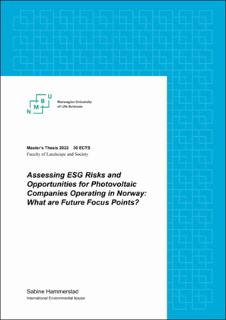| dc.description.abstract | Companies are increasingly pressured to be socially conscious and environmentally responsible by multiple sources, including political representatives, regulators, interest groups, and perhaps more than ever, by investors. The argument is crystal clear: businesses no longer exclusively serve their group of shareholders, they also have a greater responsibility for other stakeholders like customers, employees, and society. In this respect, environmental, social and governance (ESG) considerations have emerged as a major influencer on investing practices, and businesses are increasingly called upon to address and report on ESG related criteria. It may be presumed that the Norwegian photovoltaic industry, by the course of its renewable nature, is considered lucrative by sustainability-minded investors and capitalists. However, this only rationalises and accounts for one-third of the ESG metrics, and in the competitive and constantly developing Norwegian reporting environment, it can be argued that if investors increasingly use ESG criteria in their screening process, the need to identify ESG risks and opportunities will extend to solar companies as well. The task of examining ESG risks and opportunities relative to solar companies operating in Norway is yet to be done, which is what this paper intends to examine. The report is based on data collection through interviews with companies from the Norwegian solar market, a content analysis of sustainability reports from third-party companies, and literature reviews. Through the frameworks PESTEL and SWOT, the report identifies ESG risks and opportunities for photovoltaic companies operating in Norway. The study demonstrates that the most critical ESG risks are connected to the companies’ reliance on China for production and manufacturing, which presents several difficulties for monitoring and securing good environmental, social, and government practices in the entire supply chain. From the opportunity perspective, it is concluded that increased effort in filling reporting gaps and shortcomings, is rewarding for securing patient capital. | en_US |

